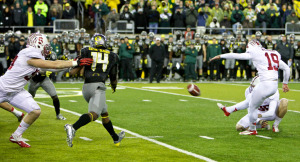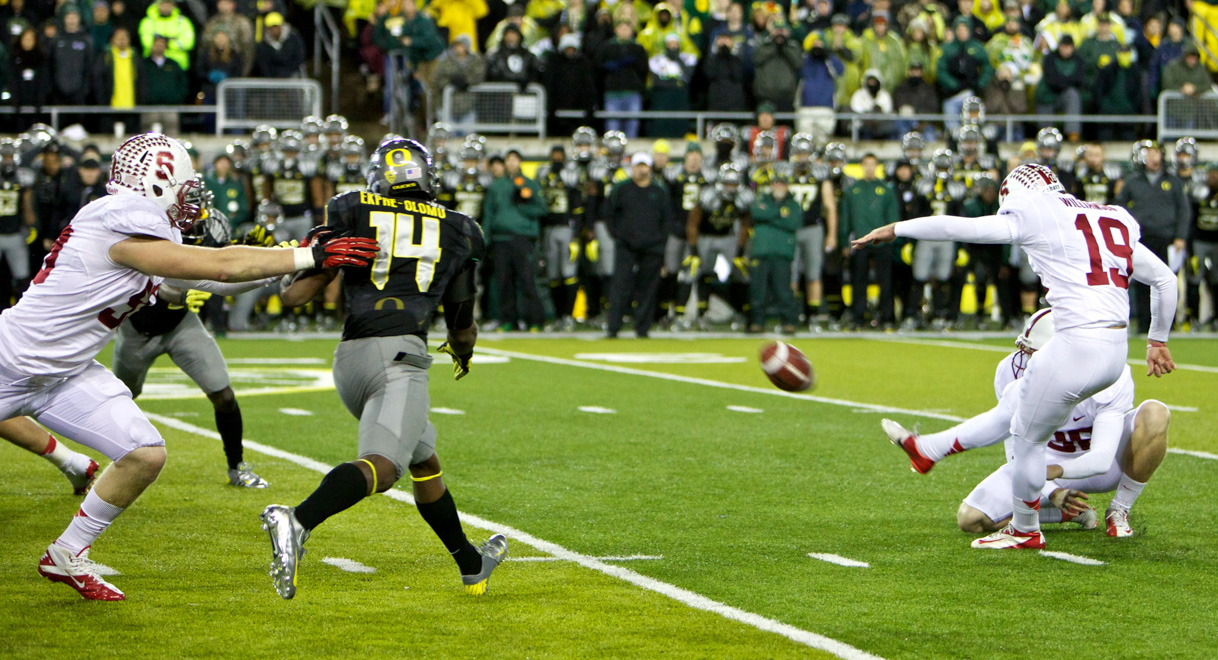Eight years ago, the college football world could not have cared less about Stanford or Oregon.
To open the 2006 football season, Oregon squashed Stanford 48-10, picking up its fifth straight victory in the series and continuing the series’ trend of one-sided affairs: The last eight matchups between the two schools had been decided by an average of 22 points.
The Ducks would finish the year a modest 7-6, while the Cardinal sank to a miserable 1-11. Neither program generated much interest — certainly not when they played each other, as there had never been a matchup between them when both were ranked in the top 25. The two schools had combined for only seven Pacific conference titles in the conference’s 38-year existence. The only rivalry between Stanford and Oregon revolved around which school could lay claim to Phil Knight and his accomplishments.
Apparently, four years must truly be a lifetime in college football.
From 2010 to 2013, the winner of the Stanford-Oregon matchup — all games in which the Cardinal and Ducks were both ranked in the top 15 — went on to win the conference and play in the Rose Bowl or the national championship game, with the winner arguably laying claim to the title of “Best in the West” each year. The series reached a peak last season when No. 3 Oregon and No. 5 Stanford squared off at Stanford Stadium in November with 5.73 million viewers watching the 26-20 thriller on television.
Though we now know Stanford-Oregon to be a premier game of the college football season, its development into a rivalry was really quite unlikely.
***
When it comes to rivalries in college football, most are founded upon proximity, history or similarities. Stanford and Oregon have almost nothing in common, both on and off the football field.

The two campuses are located 560 miles apart. It rains, on average, on 139 days in Eugene, while only on 56 days in Palo Alto. Stanford is a private school, ranked fourth on this year’s US News and World Report College rankings, while Oregon is a public institution, ranked 104th on the same list. Heck, in Oregon, people fill your gas tanks up for you. In California, you’ll find no such courtesy.
On the football field, the differences remain. Stanford runs a pro-style, traditional offense and relies on its suffocating defense. Oregon operates an up-tempo spread offense at a blistering pace while its defense just hopes to survive. The Cardinal will wear, at most, three different uniforms throughout the season. On the other hand, Oregon has over 500 different combinations of uniforms to choose from and is likely to never wear the same one twice.
“I think it’s a very different style of football,” said senior receiver Jordan Pratt, an Oregon native, about the contrast in styles between the two teams. “It’s been kind of the fast guys versus the guys who are going to play hard-nosed football.”
Unlike most college football rivalries, though, this assortment of differences between the two schools and the two football teams actually fuels the intrigue of the matchup.
“Obviously, there’s traditional uniforms, traditional pro-style offense versus new-age offense, new-age uniforms, so they’ve kind of been playing back-and-forth on all that,” said Stanford football head coach David Shaw.
“I think the power run team we’ve been against their up-tempo and spread type of offense, that’s added to the rivalry,” added fifth-year senior defensive end Henry Anderson.
However, the most important ingredient to any rivalry is the relevance of both teams. This relevancy was absent for much of Stanford and Oregon’s history, but in the late 2000s, an influx of talent on both the coaching staffs and the rosters of both programs brought swift change.
“The players that have gone through both programs have really elevated the game itself,” said senior running back Kelsey Young. “On both teams, there have been spectacular players that have lit up the scoreboards and just showed out during all the games. [The rivalry] had a lot to do with the players and also the programs both took a turn for the best.”
Though former Oregon head coach Mike Belotti is credited with establishing Oregon as a great program — the Ducks won the Pac-12 in 2000 and 2001 — the team lingered in the middle of the Pac for much of the late 2000s, recording as many fourth- and fifth-place conference finishes (three) as second- and third-place finishes from 2002 to 2008. When Chip Kelly took over the helm in 2009, though, Oregon became elite, beginning a run of four straight BCS bowls, including two Rose Bowls and a national championship appearance. Oregon may not have had to climb as big of a hill as Stanford to reach the top, but it certainly was not a regular at the top until 2009.
At the same time, Stanford’s well-documented rise took place, as Jim Harbaugh and his staff reinvigorated a stagnant program and David Shaw continued right where Harbaugh left off, with the two coaches combining to deliver Stanford to four straight BCS bowls from 2010 to 2013.
Both teams became conference and national contenders, and simultaneously, the final component necessary for any rivalry developed: competitive, intense battles on the field.
In 2009, for only the second time in 10 years, Stanford beat No. 7 Oregon 52-41, ending the Ducks’ hopes at a national championship and providing the initial spark in a series that had previously been one-sided.
“It really became a rivalry when we won in 2009 here because up until then, they had really dominated us,” Shaw said. “Andrew [Luck] played a phenomenal game, Toby Gerhart rushed for 200 yards, it wasn’t until then that we actually became somebody that Oregon actually had to look out and account for.”
In 2010, the matchup pitted undefeated, top-10 teams, with Oregon coming away victorious. Then in 2011, No. 6 Oregon ruined undefeated No. 3 Stanford’s bid for the Rose Bowl and the national championship.
Suddenly, almost out of nowhere, the Stanford-Oregon game was one of the most intriguing and relevant games not only in the Pac-12, but in all of college football.
“The fact that it’s been competitive and they’ve been exciting, nationally-televised games that have been some of the highest-rated games of the year, nationally it’s been exciting to watch and locally it’s been exciting to watch for both the fan bases,” Shaw said.
The blowout nature of the 2010 and 2011 matchups gave reason to think the rivalry was only one-sided, despite Stanford’s upset in 2009, as it seemed like Stanford “had an Oregon problem.” In 2012, though, Stanford took the beatings to heart.
“In the offseason after my freshman year, when [the Oregon game] was our one game that we really felt like we got beat…you just remember that feeling of ‘Wow, we just got it taken to us,’” Pratt said. “It was definitely that offseason where we were really preparing for them and gunning after them.”
That season, an unlikely hero in Jordan Williamson provided the turning point in the rivalry with a game-winning field goal for No. 14 Stanford against undefeated No. 1 Oregon in Eugene.
“It was a really tight game, our backs were against the wall, we had lost two games already at that point, Oregon was undefeated. Everybody thought Oregon was going to score 100 points on us. We fought through the end and came away victorious. That was a really defining moment for my Stanford career against Oregon,” said Young about the 2012 game.
“That 2012 game when we shut them down was definitely the turning point in the rivalry,” Anderson added.
Of course, last season, the rivalry only grew as Stanford thwarted undefeated Oregon’s dreams at a national championship for the second straight year. And for the fourth year in a row, the game saw an undefeated team fall while the winner stole the other’s dream and won the conference.
“Stanford is rivals with everybody in the Pac-12 but Oregon-Stanford, that rivalry has determined champions in the Pac-12 over the past few years,” Young added.
The past two years flipped the script, with Oregon now seen as the school that has “a Stanford problem.” Each school’s period of dominance only served to infuriate the other, producing a mutual fire to win.
“Two good football teams competing for the Pac-12 championship makes it a big game every year,” Pratt said. “It’s always been that game that’s circled on the schedule with a little extra incentive to bring it.”
***
Did anyone see this coming in 2006?
The concurrent meteoric rise of two relatively mediocre programs — mediocre is even a generous description of the 2006 Stanford team — combined with the rapid development of one of college football’s most intense rivalry games on a yearly basis is almost unprecedented in college football.
“It’s two of the top Pac-12 teams battling it out,” Anderson said. “The crowd’s always electric, the atmosphere’s always really fun and it’s a hard physical game that’s a lot of fun to play in.”
The fact that this year’s Stanford-Oregon game seems lackluster since the two programs have a combined four losses already speaks only to how good the rivalry itself has truly become. Even more prominently, the fact that both fan bases point to the Stanford-Oregon game as the season’s biggest game — not rivalry games against Cal or USC for Stanford and Oregon State or Washington for Oregon — signifies the rapid change from even just several years ago, when neither school really cared about the other.
Considering the state of the programs in the mid-2000s and the drastic differences between the two sides, could this rivalry be any more unlikely?
Contact Michael Peterson at mrpeters ‘at’ stanford.edu.
